Kids with hearing loss learn from scholar
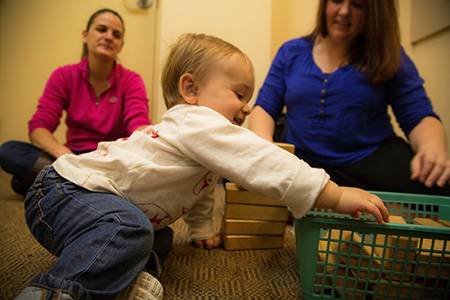
Megan Evans, MS ’15, is a student clinician working with 14-month-old Jacob Downing, who has severe hearing loss, and his mother, Lisa Downing, at the Thayer Lindsley Program at Emerson. (Photo by Tyler McAndrew ’16)
For Megan Evans, MS ’15, hearing 14-month-old Jacob Downing begin to utter the sound of the letter C causes her to get excited.
“I hadn’t heard that sound yet!” Evans said to Jacob’s mother, Lisa Downing of Wayland, as the three play with toys on the floor of the Robbins Center at Emerson College, where Jacob is receiving early intervention treatment for severe- to profound-level hearing loss in both ears.
“That’s a good one,” Lisa Downing said.
Evans, a graduate student in the Communication Sciences and Disorders (CSD) Department who received this year’s Decibels Scholar Award from the Decibels Foundation, says the playtime provides crucial speech and listening comprehension skills in infants and toddlers receiving therapy in Emerson’s Thayer Lindsley Program, which will celebrate its 50th anniversary next year. Evans works with CSD faculty members Lynn Conners, MS ’97, and Elaine Rudel ’00, MS ’02, who are clinical instructors.
“Essentially, it’s play therapy,” Evans said. “We create a language-rich environment for the child. Because these are young children, when therapy is not in the play context, it’s hard to engage them.”
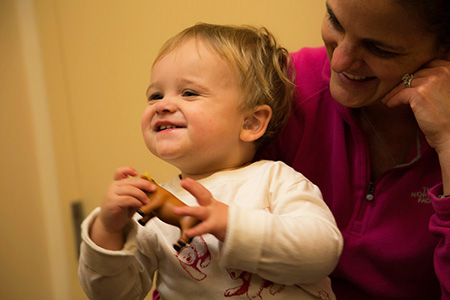
Jacob Downing and his mother, Lisa Downing, at the Robbins Center at Emerson. (Photo by Tyler McAndrew ’16)
“It’s one of the programs I’ve loved from the beginning,” Downing said. “This is where I feel the most comfortable.”
The Decibels Scholar Award—established by Mark and Julia Dunning, whose daughter went through the Thayer Lindsley Program several years ago—allows Evans to work for this academic year at Thayer Lindsley, and to work at the Minute Man Arc for Human Services in Concord, which includes home visits and therapy that involves the entire family.
Evans, the sixth of seven children, has developed an interest in speech therapy since one of her young nephews began having speech and articulation problems.
“I ask all the time how he’s doing, and what [types of therapy] they’re working on,” Evans said. “I do tend to look at my nieces and nephews through the lens of my career. I love language and studying language.”
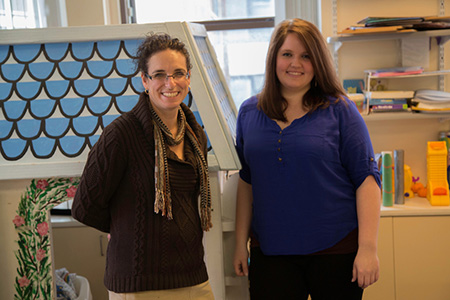
Clinical Instructor Lynn Conners, MS ’97, and student clinician Megan Evans, MS ’15, at the Robbins Center at Emerson. (Photo by Tyler McAndrew ’16)
Downing’s sessions with Evans mark the second time she has brought one of her children to the Thayer Lindsley Program. Her older son, Lucas, age 4, has severe hearing loss in one ear, for which he uses a hearing aid, and profound hearing loss in another, for which he has had a cochlear implant.
“His speech now is pretty close to normal,” Downing said of her older son. “You wouldn’t be able to tell he’s deaf if you didn’t see the aid.”
Social interaction with Evans and other children in the Robbins Center, which features an indoor playground and is where the Thayler Lindsley Program operates, has been the biggest benefit for Jacob, the younger son, Downing said.
“Now he says, ‘all done,’ ‘doggy,’ and ‘ducky,’” she said. “And, ‘daddy.’ Of course, ‘daddy’ comes first.”
In order to get toddlers to pay attention to the sounds around them, Evans and other student clinicians ask them where certain toys belong or what sounds certain animals make, for example. They also work with parents to establish routines that encourage children to interact with language at home.
“David Luterman [the Emerson professor emeritus who founded Thayer Lindsley in 1965] said, ‘If you take care of the parents, you take care of the child,’” Evans said. “It’s been really great to put that into practice.”
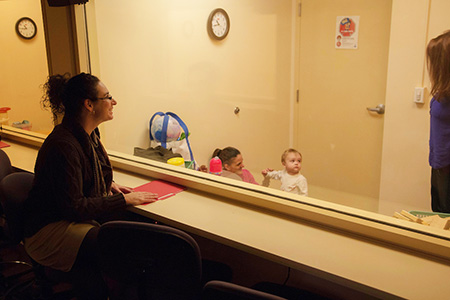
Conners observes Evans conducting therapy through a one-way mirror with Jacob Downing and his mom, Lisa Downing. (Photo by Tyler McAndrew ’16)
There is also a support group for parents—something many say is invaluable.
“I didn’t have any experience with deaf or hard of hearing people,” said Anna Claeys of Jamaica Plain, whose 1-year-old daughter, Story—her first child—was born with moderate-to-severe hearing loss in both ears. “You have this feeling that this child is going to be very different from you right from birth.”
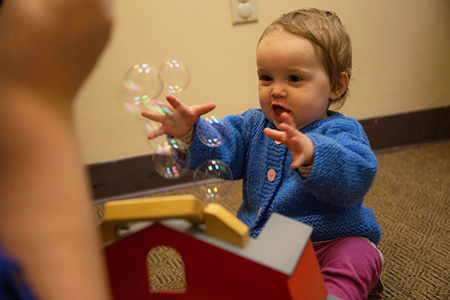
Story Claeys, age 1, plays with bubbles during a therapy session with Evans. (Photo by Tyler McAndrew ’16)
Genetics account for approximately 25 percent of children born with hearing loss, but a variety of other reasons cause it, and it is often unpredictable.
“Sometimes mothers feel guilt, especially if they feel there was something they could have done during pregnancy,” said Rudel, who oversees the parent group. “Or they feel isolated…or are afraid their children are going to be picked on. It’s important for the parents to support one another.”
Chunwen Cheng’s 2-year-old girl, Allison Lin, has moderate hearing loss in one ear, and praised the parent group for providing “so much useful information” about navigating health insurance issues after her family’s provider wouldn’t cover the cost of a hearing aid.
“It was a big help,” said Cheng, of Needham. “You learn that as long as the child’s learning process is normal, the hearing loss is nothing to worry about. The parents just have to make more effort.”
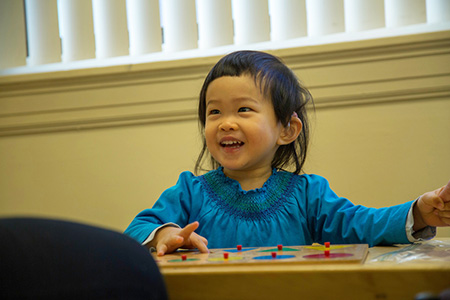
Allison Lin, age 2, receives therapy in the Thayer Lindsley Program. (Photo by Tyler McAndrew ’16)
Claeys said her daughter “is signing a ton” and calls Story’s progress “amazing.”
“This is the only time she’s interacting with her deaf and hard of hearing peers,” Claeys said. “That’s important for her self-confidence.”
Evans said it is common for infants with hearing loss—who are learning American Sign Language—to “babble” in sign language, in the same way babies without hearing loss verbalize noises as they try to form words.
Evans, who received a bachelor’s degree in communication disorders from Brigham Young University, said she would love to work in a school after graduation.
“The education setting is why I went into this,” she said. “I would love to work in early intervention with children…and keep working with this population. It’s such an interactive community and there are so many opportunities to help.”
Categories